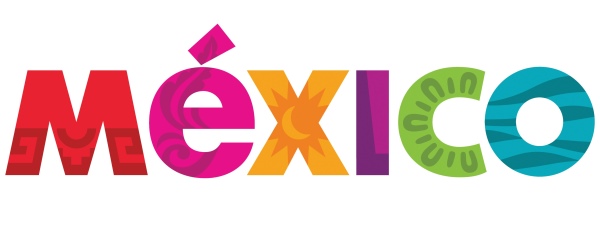Despite having seen this tourist promotion logo thousands of times, I had never thought about its colors and their significance until recently.
 It turns out that the colors (despite what you may see on your monitor) are actually meant to be:
It turns out that the colors (despite what you may see on your monitor) are actually meant to be:
- M – brown = archaeology and archaeological sites (historical tourism)
- é – pink = health and well-being (including medical tourism)
- x – yellow = culture (cultural tourism)
- i – purple = meetings (seminars and conference tourism)
- c – green = nature (adventure tourism and ecotourism)
- o – blue = sea, sun and sand (beach and resort tourism)
The federal Tourism Secretariat is planning a nationwide overhaul of tourism signage on major highways taking advantage of these colors. It will install new, standardized signs using these six colors as a quick means of identifying the kind of tourist attraction at each location of interest. The program has funding of almost $10 million, and the first states to have the new signs will be Chiapas, Durango, Guanajuato, Hidalgo, Jalisco, Michoacán, Puebla, Tabasco, Tlaxcala and Veracruz.
Whether or not using six different colors is actually more effective than six distinct symbols on the same color background remains to be seen.
In the first half of this year, Mexico received 17,000,000 international tourists, 8.6% more than for the corresponding period in 2015, with expenditures by tourists rising 8% to $10.063 billion.
Related posts:
3 Responses to “Mexico’s tourism logo: the basis for colored tourism signs”
Sorry, the comment form is closed at this time.
Hmmm, Interesting, but if you didn’t know about the color signifcance, what are the chances that anyone else will know? Especially tourists.
When I saw your headline I thought you would be dealing with a totally different matter. And I doubt there are any statististics for this. I have often wondered why I have never seen more tourists of color – i.e. african americans or dark skinned tourists from elsewhere. Where do they go during the cold northern winters?Or the hot Texas summers And why do so few come here? Phyllis
On this occasion, I don’t have any answer for you! What has emerged, while I’m researching the history of the artists and authors, is that in the 1950s-1970s they included quite a number of African Americans, including some well known ones.
Dark skinned tourists from the US come to the Yucatan at least, on cruise ships. Very rare to see individual families or groups of African Americans. Asian Americans also are rare, but are coming more. The latter generally does a Mexico trip that starts somewhere in central Mexico and meanders down to Cancun through all the interesting sites along the way.